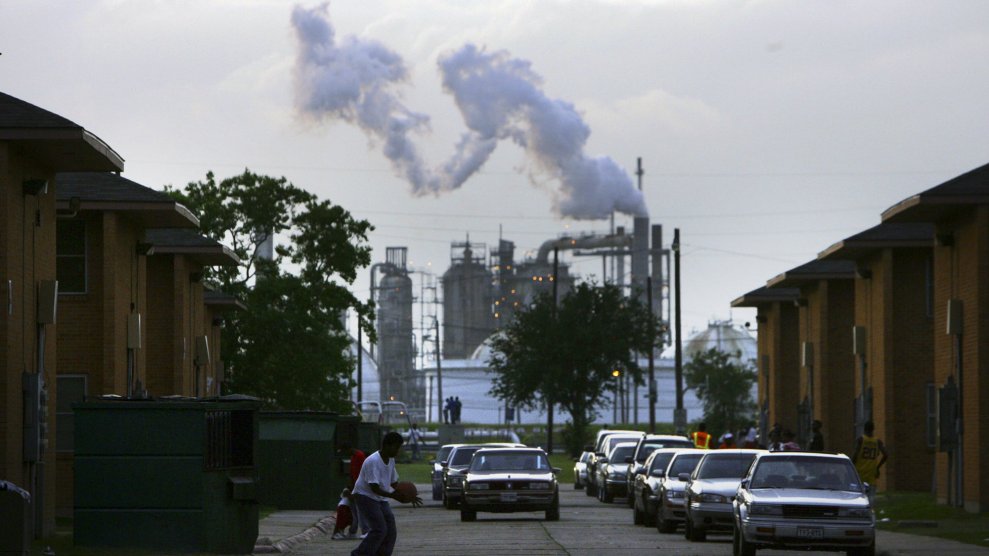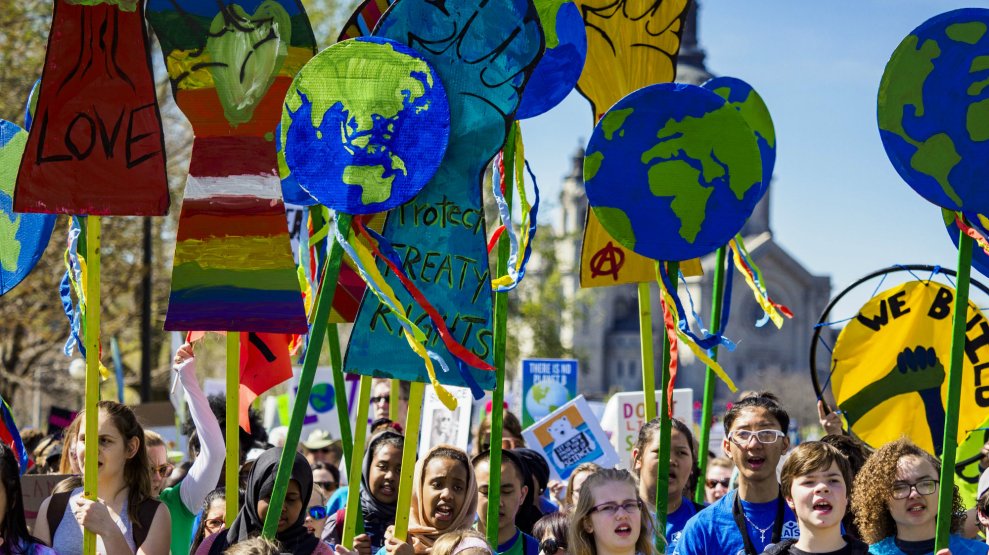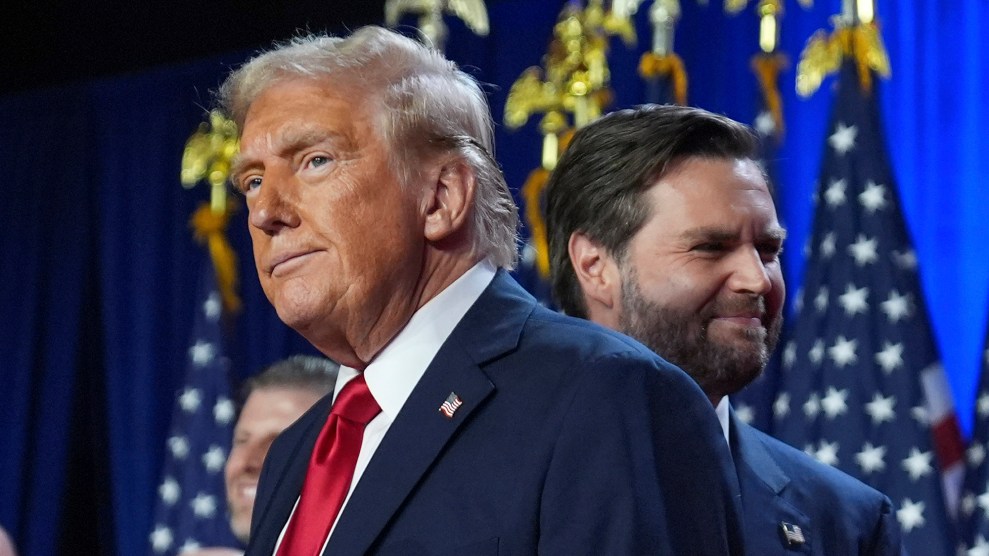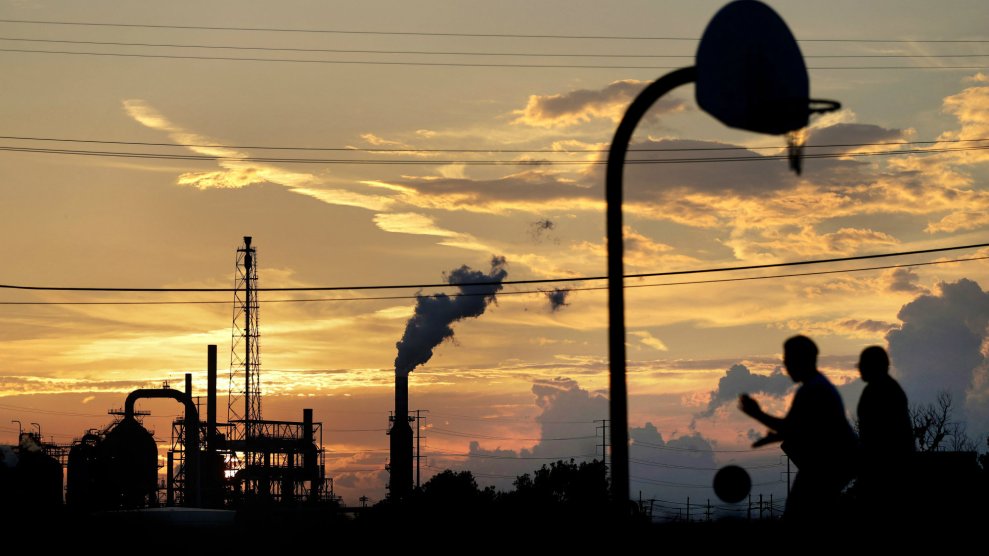
Children play basketball in Port Arthur, Tex. neighborhoodDavid Goldman/AP
This story was originally published by The Guardian and appears here as part of the Climate Desk collaboration.
The Trump administration’s dismantling of environmental regulations has intensified a growing civil rights battle over the deadly burden of pollution on minorities and low-income people.
Black, Latino, and disadvantaged people have long been disproportionately afflicted by toxins from industrial plants, cars, hazardous housing conditions and other sources.
But political leaders, academics and activists spoke of a growing urgency around the struggle for environmental justice as the Trump administration peels away rules designed to protect clean air and water.
“What we are seeing is the institutionalization of discrimination again, the thing we’ve fought for 40 years,” said Robert Bullard, an academic widely considered the father of the environmental justice movement.
“There are people in fence-line communities who are now very worried. If the federal government doesn’t monitor and regulate, and gives the states a green light to do what they want, we are going to get more pollution, more people will get sick. There will be more deaths.”
Activists and some in Congress now view the blight of pollution as a vast, largely overlooked civil rights issue that places an unbearable burden on people of color and low-income communities.
Senator Cory Booker, a Democrat from New Jersey, recently said: “Civil rights have to include, fundamentally, the right to breathe your air, plant tomatoes in your soil. Civil rights is the right to drink your water.
“If your children don’t have access to clean air and water, all the ideals we preach in this country are a lie. Environmental justice must be at the center of our activism in our fight to make real the promise of America.”
Who lives near Superfund sites?
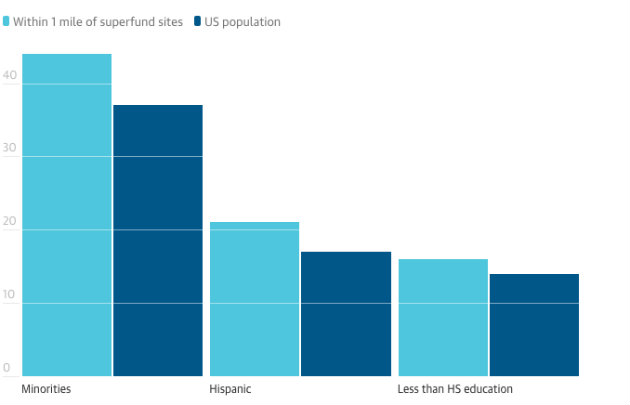
Source: Environmental Protection Agency, Office of Solid Waste and Emergency Response, 2013
Guardian Graphic
Last month, Booker unveiled new legislation, supported by a group of senators including Bernie Sanders and Elizabeth Warren, that he said would help eliminate environmental injustice. The bill would require federal agencies to address the issue, force authorities to consider existing pollution when allowing new industrial facilities and hand individuals the power rto use the Civil Rights Act to sue over pollution.
Mustafa Ali, who helped create the Environmental Protection Agency’s (EPA) office of environmental justice and worked there for 24 years, told the Guardian he’s been alarmed by proposed EPA budget cuts and the federal government’s heavily criticized response to the ongoing humanitarian disaster in Puerto Rico, which was struck by Hurricane Maria in September.
“I left the EPA because of the proposals to roll back legislation that will have direct impacts on local communities,” he said. “Ten months in, they have yet to move forward any action to help communities be healthier. People in Puerto Rico are drinking toxic water. Unfortunately, so far, I’ve been proved right in my decision to leave. I wanted them to prove me wrong.”
The Trump administration has targeted dozens of regulations it says have stymied economic growth. It has moved to axe an Obama-era plan to reduce emissions from coal-fired power plants, delayed new standards to cut toxic fumes from vehicles and dropped a proposed ban on a pesticide linked to developmental delays in children.
An EPA spokeswoman said the agency was “pursuing commonsense reforms that reduce regulatory burden while maintaining environmental and public health protection”. She said the agency’s leadership was “refocusing EPA on its core mission” to tackle the most significant environmental and public health problems.
“Under the nation’s environmental laws, the US has made great progress in cleaning up the air, land and water,” she said. “However, we acknowledge that many low-income, minority and tribal populations still bear a disproportionate burden of potential risk from sources of pollution.”
The Trump administration’s proposed budget outlined a plan to close the EPA’s office of environmental justice, although this plan now appears to have been shelved with the office shifting to be directly under the purview of the EPA administrator, Scott Pruitt.
“This move is a reaffirmation of administrator Pruitt’s commitment to the mission and goals of the agency’s environmental justice program,” said the EPA spokeswoman.
But Ali said there was little evidence the agency is focused on vulnerable communities, claiming it is a “particular slap in the face” that the EPA wants to cut funding for anti-lead programs given that the largely black city of Flint, Michigan, continues to suffer from lead-tainted water, three years after the scandal was exposed.
Recent high-profile controversies such as Flint, where a series of failures allowed lead to leach into the drinking supply, and the Dakota Access pipeline, where protestors in North Dakota have clashed with police over concerns the Standing Rock tribe’s water will be contaminated, have elevated the profile of environmental justice. But similar problems have dotted the US for years, often lingering stubbornly.
Booker recently embarked on a tour of festering environmental problems suffered largely by minorities, including a North Carolina community next to hog farms that spray untreated waste on to nearby fields, meaning that opening windows or hanging washing outdoors are risky endeavors. The industry dismisses these claims.
Booker also visited Uniontown, Alabama, which he said had been “ruined” by a giant industrial waste dump and the so-called “cancer alley”—communities that live alongside an infamous corridor of petrochemical plants in Louisiana. But he said it wasn’t necessary to travel far from his home state to understand the problem.
“I became an environmentalist, I have to be candid with you, not because of the effects of global warming some time in the future,” said Booker, a former mayor of Newark, New Jersey, at a time when the city was experiencing its own problems with lead contamination of drinking water. “I became an environmentalist because I saw horrific examples of environmental injustice and how it was hurting my community in every single way.”
Black communities are most exposed to solid waste facilities in North Carolina
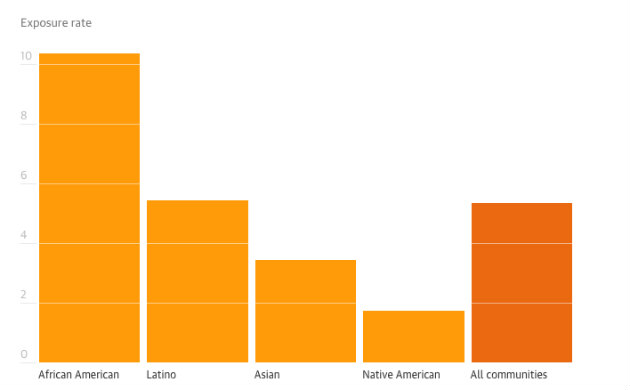
Source: University of North Carolina Center on Civil Rights, 2013
Guardian graphic
Against the unusually industry-friendly approach adopted by the White House and EPA, as well as a Republican-controlled Congress, Booker’s bill has little foreseeable chance of becoming law. But it signals a fresh determination by activists to put pollution on the same civil rights footing as other issues, such as criminal justice.
“It’s definitely moved up the priority list,” said Ali. “I wasn’t around late 1960s and 1970s, but people talk about a spirit of civic engagement then. We are seeing a new round of that now.”
The roots of the environmental justice movement are diffuse, but a string of events in Houston, Texas, proved foundational. In 1967, an eight-year-old black girl drowned at a landfill dumping site that was placed in a heavily African-American neighborhood. Community members picketed the site, joining forces with other protesters who were agitating against racism in the city’s schools.
A decade later, Bullard, then a sociologist at Texas Southern University, began to study the placement of toxic sites in Houston and discovered an alarming pattern. All five city-owned landfills and six out of eight city-owned incinerators were placed in black neighborhoods, despite black people making up just a quarter of Houston’s population. Bullard said instead of Nimby politics, there was what he called Pibby (Place in blacks’ back yard).
US counties with the highest rates of heart attack deaths

“I was shocked and angered by what I saw in Houston,” Bullard said. “I then started to look at Dallas, at Louisiana, at West Virginia, at Alabama. Houston wasn’t atypical at all. Residential apartheid was happening everywhere.”
Years of racist housing policies, tacitly and explicitly approved by government, and a lack of political clout made minorities close neighbors for manufacturing plants, landfills, power stations and other potentially toxic facilities. State-led pursuit of polluters, particularly in some southern states, has been tepid.
The environmental movement was initially slow to see its cause as being intertwined with civil rights. “We love polar bears, birds and wetlands, but we also want to talk about children being poisoned by lead,” said Dr Benjamin Chavis, a civil rights leader who was an assistant of Martin Luther King Jr.
“We had a lot of education to do with very smart white people in the environmental movement. We had to call out their paternalism and racism. They said they don’t deal with social issues, like breathing air was a niche social issue.”
The issue of environmental justice, aided by the research of Bullard and many others since, is now both understood and persistent.
Of all the people who live within three miles of the most toxic sites in the US, known as superfund areas by the EPA, 46% are minorities – a proportion far higher than the 37% national non-white population.
US counties with the highest rates of breast cancer

One in three Latinos live in areas that violate federal standards for ozone, a pollutant that causes smog and is linked to an array of health problems. The thousands of abandoned mines that dot the western US have left a legacy of soil and water contamination that blights native American tribes, such as the Navajo nation.
Nearly seven in 10 African Americans live within 30 miles of a coal-fired power plant, compared with 56% of whites. Once the coal is burned, its ash, which can damage the nervous system and cause cancers if ingested or inhaled, is dumped in about 1,400 sites around the US – 70% of which are situated in low-income communities.
Oil and gas operations also loom over many black neighborhoods, potentially exposing them to a stew of chemicals including benzene, sulfur dioxide and formaldehyde.
“The effects of oil and gas pollution are disproportionately afflicting African Americans, particularly cancer and respiratory issues, and the trend is only increasing,” said Dr Doris Browne, president of the National Medical Association.
“Our membership is seeing far too many patients in communities of color suffering from these diseases. It is our goal to fight to reverse this dangerous trend.”
More than 1 million African Americans live within half a mile of an oil or gas facility, according to research compiled by the National Association for the Advancement of Colored People (NAACP) and the Clean Air Task Force. An even larger black population – around 6.7 million people – live in a US county that also features an oil refinery.
The NAACP maintains that “fence-line” communities near industrial plants emerge when energy companies target certain neighborhoods that then enter a gloomy spiral that forces property values and traps residents. The organization has recently expanded its campaigning to focus on how communities of color are now bearing the brunt of natural disasters, such as the recent hurricanes in Texas, Florida and Puerto Rico, that are supercharged by climate change.
“The main factor is race – poor whites do better than middle-class blacks,” said Bullard. “Housing discrimination is so entrenched in America that money doesn’t buy you out of segregated neighborhoods.
“A white person who is poor can put on a suit and tie and look for an apartment. They are seen as a regular person. A black person will meet discrimination, which drives who lives where and what is located there. You see this pattern all over – parks and grocery stores and so on aren’t located in black neighborhoods. But pollution is.”
America’s air is generally far more breathable and its water broadly safer to drink than the 1970s, but discrepancies remain, including among children, who are acutely susceptible to airborne particulates that cause respiratory problems and lead-laced water that can hinder development.
More than 14% of black children in the US have asthma, compared with 8% of white children. Black children are also much more likely than their white counterparts to be hospitalized due to the condition.
Pollution often lingers at both home and at school – about one in 11 US public schools sit within 500ft of a highway or other major road. Studies have linkedheavy traffic to childhood asthma.
Federal action began to ramp up in the early 1990s, with a small but dedicated environmental justice office opening within the EPA and the then president, Bill Clinton, penning an executive order demanding government agencies acknowledge the issue and deeming environmental racism as contrary to the Civil Rights Act.
The EPA has been repeatedly criticized since this point for its sluggish approach to protecting minority communities from insidious pollution, but the final year of the Obama administration saw a new plan to bolster environmental justice and beef up enforcement. These modest gains could now be snuffed out under a Trump presidency.
“This administration has pushed us into the gutter”
“We had to struggle under George W Bush but we weren’t pushed into the gutter – this administration has pushed us into the gutter,” said a senior EPA official who recently departed the agency. “These communities depend a lot on the EPA, they don’t have much sustainability in them. I just hope we don’t go so far back that we can’t pull it around.”
The prospect of a backwards step horrifies those who have already suffered from America’s pollution inequity. In 2002, Sheila Holt-Orsted noticed a cluster of cancers in her hometown of Dickson County, Tennessee, including her father and aunt. Babies were being born with deformities, such as cleft palates.
Despite being a healthy former bodybuilder who had since moved to Virginia, Holt-Orsted was worried enough to head to the doctor, who informed her she had stage two breast cancer.
“Once I picked myself up off the floor, I felt I had to do something, so I decided to move home to find the common denominator,” she said. By digging through county and state records, Holt-Orsted found out that a landfill, located less than a mile from her family’s house, was leaking trichloroethylene (TCE), an industrial solvent that is a known carcinogen and neurological toxin, into the drinking water supply at levels far higher than EPA’s safety standards.
Not only was the landfill placed in the heart of Dickson County’s African-American enclave, which included the Holt-Orsteds, but the remediation of the issue was also drawn along racial lines. Holt-Orsted was handed records that showed official state letters were sent to white households warning of the contamination, while black families were sent letters claiming the water was safe to drink.
“It was ignorance, it was racism,” Holt-Orsted said. “Our community was the sacrificial lamb for this landfill.” What followed was a 10-year legal battle that finally forced the authorities to address the pollution and connect households to a clean water supply. “Even then, some of the white people in the town said we were just some niggers looking for money,” Holt-Orsted said.
The more recent water contamination in Flint was “sickening”, Holt-Orsted said, and she worries that further outrages will occur if regulations and enforcement is forgone in favor of industry-friendly bromides.
“The Trump administration will have a huge affect on everyone,” she said. “It’s scary to see how much they are siding with industry. All industry thinks about is how much money to make and that’s exactly what happened in Dickson.
“I had never heard of environmental racism until I was a victim of it. It’s sickening that this is going on in America.”
Data research by Mona Chalabi
